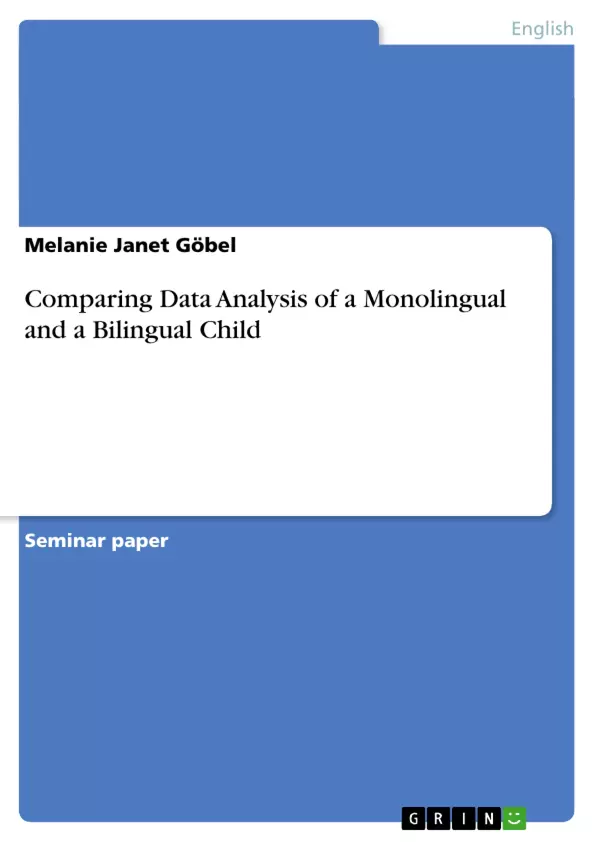Have you ever read a newspaper article about bilingual children? Well, I guess everybody has come across at least one of them. Is it not an interesting matter of fact that bilingual children apparently learn a second language easier than monolingual? But after reading those texts have you ever asked yourself where exactly the differences between monolingual and bilingual children in second language acquisition (SLA) are? I did and therefore I investigated in comparing data of a monolingual and a bilingual child. Consequently in my analysis I will not focus on one particular error but I will take in account all errors made by my subjects. I will start my paper with giving you some background information about the subjects´ native languages. The monolingual child´s native language (NL) is German, the bilingual child´s mother tongues are German and Arabic. I will show you the most important differences between English, German and Arabic. Because I did not find a useful Arabic grammar (in fact the problem was that I can not read Arabic letters) I asked a friend of mine to translate some sentences. Therefore you will find a comparative table of English, German and Arabic in Appendix I. In the next part I will tell you something more about my subjects and about the requirements they had to fulfil. Then I will discribe how I collected the data. The complete data will be found in Appendix II. The next step will be a presentation of my results. First I will tell you how the data was scored. Afterwards there will be a detailed description of each error made by my subjects and I will try to analize why they occured. Finally I will draw a conclusion out of my results.
Inhaltsverzeichnis (Table of Contents)
- I. Introduction
- II. Background
- III. Methodology
- IV. Results
- IV.1. Interview
- IV.2. Yes/No Questions
- IV.3. Appropiate Question to a Given Statement
- IV.4. Conditional Sentences
- IV.5. Relative Clauses
- IV.6. Total Results
- V. Conclusion
Zielsetzung und Themenschwerpunkte (Objectives and Key Themes)
This paper investigates the differences in second language acquisition (SLA) between a monolingual and a bilingual child. By comparing data of a monolingual child (native language: German) and a bilingual child (mother tongues: German and Arabic), the author analyzes various errors made by the subjects in acquiring English. The focus is on comparing the subjects' errors in diverse grammatical structures and exploring potential reasons for these errors. This comparison helps to identify potential differences in language acquisition processes based on native language background.
- Analysis of errors made by a monolingual and a bilingual child in acquiring English.
- Comparison of the subjects' errors in various grammatical structures, including definite and indefinite articles, copula usage, verb conjugation, sentence structure, and questions.
- Investigation of potential reasons for errors based on the subjects' native language backgrounds (German and Arabic).
- Exploration of potential differences in language acquisition processes between monolingual and bilingual children.
- Highlighting the impact of different linguistic features of English, German, and Arabic on SLA.
Zusammenfassung der Kapitel (Chapter Summaries)
I. Introduction This chapter introduces the topic of bilingual children and their apparent ease in acquiring a second language. It outlines the paper's objective: to investigate and compare the data of a monolingual and a bilingual child in acquiring English. The author also provides a brief overview of the paper's structure, highlighting the sections that discuss the subjects' native languages, methodology, results, and conclusions.
II. Background This chapter explores the linguistic backgrounds of the monolingual and bilingual subjects. It focuses on the similarities and differences between English, German, and Arabic, particularly in terms of definite and indefinite articles, copula usage, verb conjugation, sentence structure, and questions. The author provides a detailed analysis of each language, highlighting key features and differences that may influence second language acquisition.
Schlüsselwörter (Keywords)
The primary keywords and focus topics include second language acquisition, bilingualism, monolingualism, error analysis, English as a second language, German, Arabic, comparative linguistics, grammatical structures, definite and indefinite articles, copula, verb conjugation, sentence structure, questions, word order, linguistic differences, language acquisition processes, language transfer, cross-linguistic influence.
- Citar trabajo
- Melanie Janet Göbel (Autor), 2003, Comparing Data Analysis of a Monolingual and a Bilingual Child, Múnich, GRIN Verlag, https://www.grin.com/document/34393



